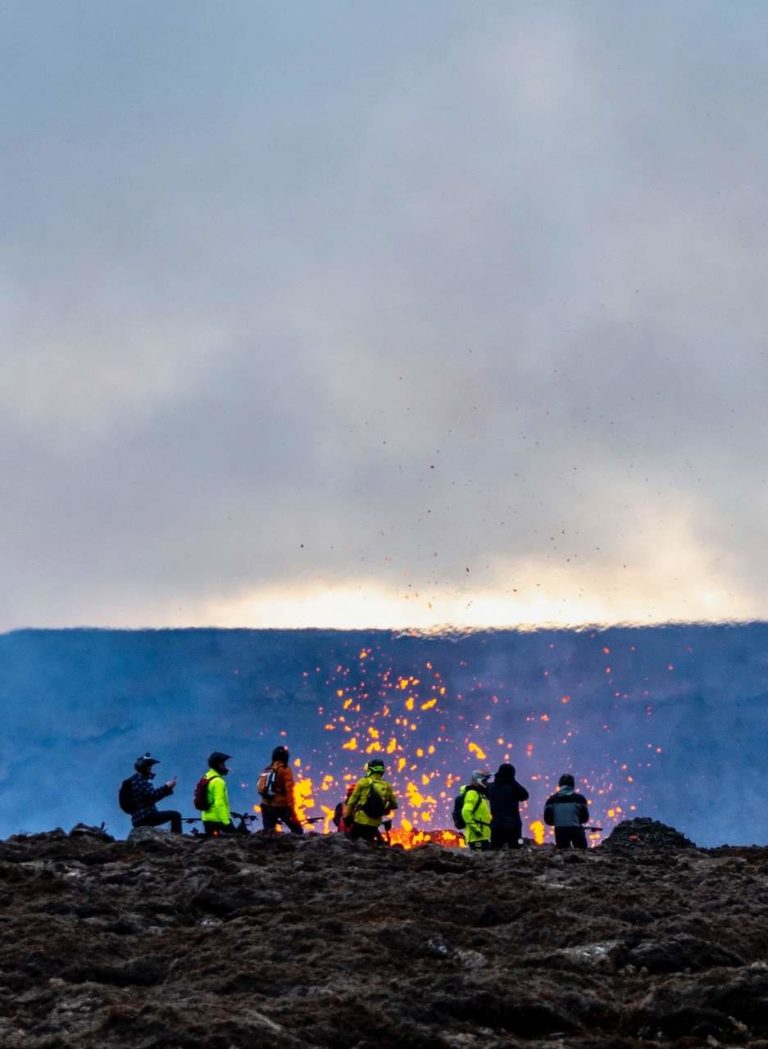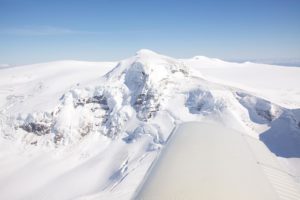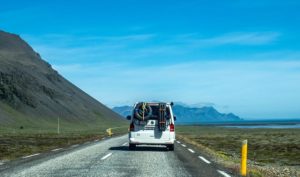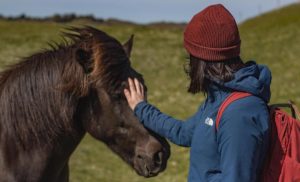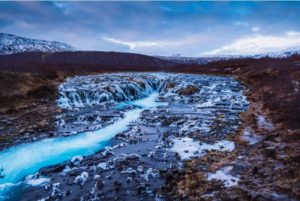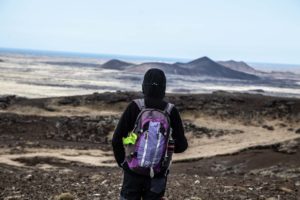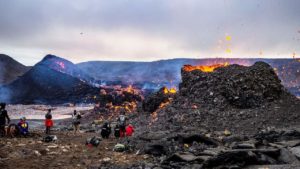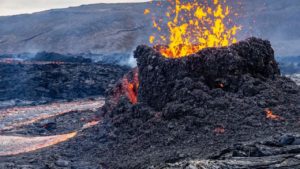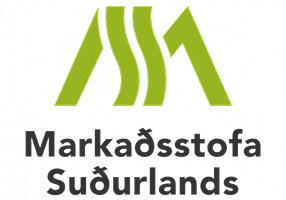How is it possible that a volcanic eruption has become the country’s greatest attraction?
The new Icelandic volcano in the Geldingadalur Valley near Fagradalsfjall on the Reykjanes Peninsula, just 60 kilometers from Reykjavik, draws crowds. From the first day after the outbreak of March 19, hundreds of people went on the hiking trail from Grindavik, and at the end of the month their number was staggering – over 5,000 hikers a day. This is more than the biggest attraction of the region and Iceland in general – the Blue Lagoon – attracted in times of tourism prosperity.
It is undoubtedly the best-documented and most human eruption in world history. The relatively short tour to the volcano site, slightly over an hour-long and medium-difficult march allows photographers and filmmakers to take drones and cameras, not to mention helicopters and planes regularly arrive at the eruption site. Or the 24/7 live media coverage from the live cameras.
The whole world is watching the volcanic eruption in Iceland. Volcano lovers from every corner of the earth gather, for example, in Facebook groups, constantly commenting and analyzing events in Iceland. Opening a new rift, destruction of the TV camera by lava, reduced or increased gas emissions – nothing escapes the discerning observers. And those who live in Iceland, especially in its southwestern part, visit the volcano regularly. Initially, there was even a kind of picnic there, including grilling sausages on the lava, and the Kaleo band recorded a music video for the song “Skinny” at the volcano site as well. Many people still spend many hours a day in front of the lava-spewing fissures.
Where extreme meet even more extreme
Iceland is called the land of “ice and fire”. The presence of glaciers covering about 11 percent of the island and harsh winters alongside the ubiquitous signs of the site’s strong volcanic activity are the best evidence that a small island in the middle of the Atlantic Ocean is doing quite well at connecting the two extreme elements. This is due to the unique location of Iceland. On the one hand, the proximity to the North Pole, being on the border of the Arctic Circle, and the ocean around us, bring moderate low temperatures, rapidly changing weather, often turning into extreme – and fascinating – phenomena. On the other hand, the location of the island on the Mid-Atlantic Ridge, at the junction of two tectonic plates – Eurasian and North American. That makes Iceland one of the most volcanically active places in the world. Volcanic eruptions are simply expected here.
When a series of severe earthquakes in February and March hit Reykjanes Peninsula and were felt not only the capital district but also other parts of the island, many wondered if a potential eruption in Reykjanes would help Icelandic tourism recover from the pandemic crisis, as did Eyjafjallajökull „contributed” to this after the 2008 economic crisis. The combination of a volcanic eruption, which was reported by the media around the world, with a positive and intense advertising campaign for Iceland brought surprisingly good results. Today we have no doubt that if the eruption lasts longer, it will be one of Iceland’s greatest attractions, attracting millions of tourists.
While it is very difficult to predict what the future of the eruption will be, it can be safely
said that the volcano at Geldingadalur is the best Iceland has been able to get at the present time. Leaving aside the potentially positive effects on tourism, focusing Iceland’s attention on the powerful and primal magnetically attractive force of nature offers – so much desired today – the opportunity for detachment from reality and excitement.
Meanwhile, volcanic eruptions are rarely associated with the festival mood and accessibility seen in Iceland today. After all, volcanic eruptions are de facto natural disasters and usually terrifying. Approaching the eruption site is, generally, perceived as an extremely dangerous activity, most often available only for volcanologists equipped with special suits and accessories.
So what makes the new Icelandic volcano so accessible and potentially harmless?
First: the eruption site. After the opening of the first rift, volcanologists monitoring the events on Reykjanes said it was “the best possible place”. The new fissure has opened up relatively far from civilization and is surrounded by mountains that the lava would have to overcome before reaching lower places – the Suðurstrandarvegur road or the town of Grindavik.
It is also a fissure eruption devoid of significant explosiveness, thanks to which pyroclastic material is not thrown into the air, as was seen, for example, during the Eyjafjallajokull explosive eruption in 2010. Air pollution is therefore negligible, there is no risk of being covered with volcanic ash, and gas emissions – especially carbon dioxide (CO₂), sulfur dioxide (SO₂), hydrogen (H₂), hydrogen sulfide (H₂S) and carbon monoxide (CO) are also relatively low. The rate of lava flowing from the craters is also not high – on average 5-6 meters per second (after opening a new fissure these numbers increase slightly) – it allows it to be “controlled” quite well, or at least to predict the direction of its flow. For comparison, this is about a thousand times less than the Holuhraun eruption in Iceland in 2014-2015. Much larger and quite significantly influencing the life of the island (mainly due to air pollution), and even so called here by guides “tourist friendly eruption”.
From the center of the earth
Okay, we already know that. Question: Why is this eruption so characteristic? Of course, it is difficult to answer this question unequivocally as volcanoes are difficult to study. You can’t just open the ground and look at what’s going on a dozen kilometers down. However, there are phenomena that we can measure that can tell us something about the nature of the new volcano.
First of all we have lava measurement, which is our best link between the interior of the earth and its surface. After all, it just comes out of there. Something very interesting emerges from the research on lava bits. In order to understand the uniqueness and specificity of the Geldingadalur volcano, we must refer to geological knowledge, which – in this case – is particularly fascinating.
There are several types of eruptions and lava, and they can be divided according to the type of material and the way it is extracted from the crater. The most general division is effusive, explosive and mixed eruptions. The possibility of their occurrence is influenced by many factors, including what is happening in the so-called magma chamber. It is a kind of reservoir
in the earth’s crust where the magma flowing into it from deeper parts is collected. When it stays there for a long time, it begins to melt the fragments of the shell surrounding it, which fall into the chamber, adding (or contaminating it) with new minerals. In this case, we are talking about magma that “evolved”. The gases present in the magma, combined with the increasing pressure, most often lead to a violent ejection above the earth’s surface, which may contribute to the occurrence of an explosive eruption.
“Our” eruption is calm, crevice-like, and the lava comes to the surface gradually. This suggests that the magma chamber is either non-existent or temporary. The chemical composition of the lava indicates that the lava did not spend a long time (or not at all) in the chamber. We are talking primarily about a high magnesium index (Mg). The mantle of the earth contains much more of it than the crust, so the large amount in the magma suggests that it comes from this depth. So, basically, what we can assume now is that the lava we witness at Geldingadalur is going almost straight from the mantle. Isn’t it fascinating?
This is also evidenced by the exceptionally high temperature of the lava (over 1,200 degrees Celsius). Plus, the type of magma which is pahoehoe. The name of the lava comes from Hawaiian the language and means “a lava that is good to walk”, because its surface is smooth (comparing to the AA’ lava, which is much thicker and after it solidifies forms sharp rocks). In Icelandic we call this lava helluhraun. You can recognize it from the “ropes” that are covering its surface.
Can it last hundred years?
All of this indicates that current eruption resembles the “dyngju” eruptions, that is, those that create huge shield volcanoes. Examples of such volcanoes in Iceland are Skjaldbreiður and Trölladyngja. The area of this type of volcano can reach tens of cubic kilometers. They are formed during calm and very long eruptions. We are talking about tens, and in some cases even hundreds of years. These types of eruptions were quite frequent in Iceland at the end of the Ice Age, causing by the melting glaciers. Snæbjörn Guðmundsson, a geologist at the Natural History Museum in Iceland, notes in his work on Geldingadalur that perhaps the eruption today has similar connotations, but to a much lesser extent. However, after this period the fissure eruptions took over and we almost forgot about dyngju. Until now?
That would explain why this eruption is so accessible and easy to manage. Even if it is not dyngju (it is just way too early to be sure) the character of it and type of lava are important factors of the site being relatively safe. However, what is important to remember is that calm or not – it is still a volcano and might be unpredictable. The very proof is the last two weeks, when few new fissures have opened without any notice or clear indications. Geologist can more or less predict where the next fissures will possibly open or what is the direction of the new lava flow, but it can suddenly change or surprise us. Same with the gas pollution – it is small, but it’s still a dangerous gas coming out of the volcano. Being extra careful, not coming close to the lava, not walking on to freshly solidified lava and bringing a gas mask is something we should always remember while visiting the site.
According to the poll done by Gallup month after eruption, about 25 percent of Icelanders have already visited an eruption site. There are many people who have seen the glow of the volcano without actually going there, but a quarter of those who hasn’t seen the eruption at all is planning to go there soon. Moreover, there is nothing to suggest that the eruption
should end soon. It seems we have to get used to the presence of this fascinating and beautiful, but also potentially dangerous force of nature.
Kaśka Paluch

